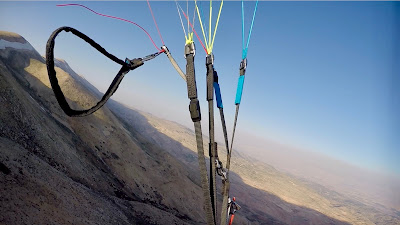And the Knight came…
Back positioning system (Shark nose) , 5.4 aspect ratio, 3.8 AR projected. If you hold and look only at the lines and risers, you think you are on the 777 King. Unsheathed lines on top and regular on the lower part with exactly the same width! Impressive.
Triple seven messages are clear…at first sight, performance is ‘one’ important target.
The overall construction of the knight is super neat.
I flew the Knight SM at 93 all up in some turbulent air and strong conditions in our Cedars range.
Launching the Knight in nil wind is smooth and super easy. In strong wind, a dab on the brakes when the knight is above the pilot’s head will be better to control it overhead.
In the air, the Knight overall movements in pitch and roll weather in moderate or strong air, are super smooth and very well coordinated! It feels exactly like a low B in dampening feel with this exquisite little spice, which let the pilot, feels every movement of the air smoothly and very accurately!
I didn’t feel at any time that ‘dull’ feel found usually on the low B gliders…Instead the Knight delivers a very comfortable feel no matter how rough conditions are, with this little touch of magic, that informs the pilot about what’s going on in the air in a super smooth way!
The Knight can be steered by a small amount on the brakes. I can describe the authority on the brakes as moderate to short, linear, precise, direct, agile…And I LOVE it! For a low B the Knight has the ‘dream handling’ Thermalling with the Knight is a real pleasure…I could control the turning radius by little precise brake inputs. Tight turns or large turns without that ‘common dive’ usually found on the low B’s. The turning radius on the Knight is very efficient. Flat turns can be made to optimize the climb in weak thermals. The knight has much better agility and more brake authority than the Rook 2 for example.
Trying to stall the Knight is difficult with hands lower than the seat board and lots of pressure. It’s really difficult to reach the stalling point.
Efficiency in an important word in the paragliding world. Creating efficient gliders in their respective categories is the most difficult part. The Knight cuts through the air-mass without any pitch back, or even a pitch forward. It just cut through peacefully, efficiently, like any good B glider would do. I didn’t feel at any time that I was being pushed away or bumping into the air-mass. The Knight was delivering a smooth efficient ride through the air.
The knight climb rate is on par with the best B’s available today, even the higher rated ones!
The overall glide performance is right on top of the low B category, and could reach some higher rated B glider easily.
The Rook 2 has the edge in the top speed glide.
The difference between the Tequila 4 that I liked, and the Knight is the extra comfort and smoothness in flight the Knight delivers with very close authority on the brakes, without the dive in turns.
The speed bar is easy to use with moderate pressure. The knight SM has a long speed bar travel, and when the pulleys are overlapping, I could see a 12 km/h over trim taken at 2800 ASL.
At bar, +8 km/h over trim is usable in all conditions.
Big ears are stable and reopen by the pilot input. They are efficient in descent rate.
Induced asymmetric are easy to countersteer and reopen quickly. Full induced frontal makes a ‘rosette’ but a little dab on the brakes and it opens as fast as lightning.
Conclusion: IMHO, Triple Seven has created a ‘master piece’ for the low B category. The impressive cocktail of climb, glide, handling, comfort, ease of use, authority on the brakes, efficiency, is very rare to be found on a low B glider on the market today.






